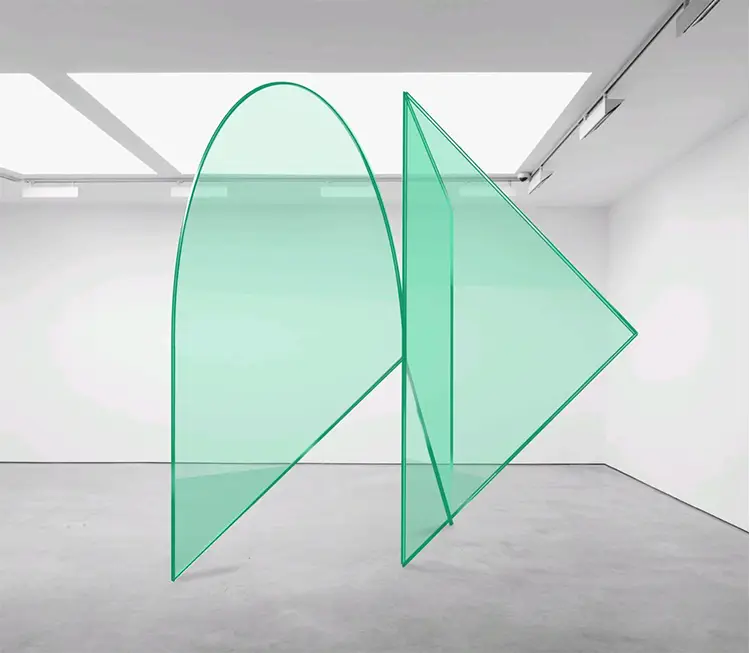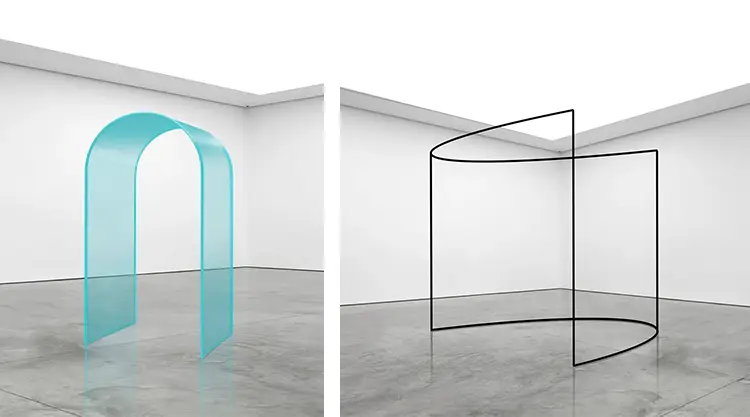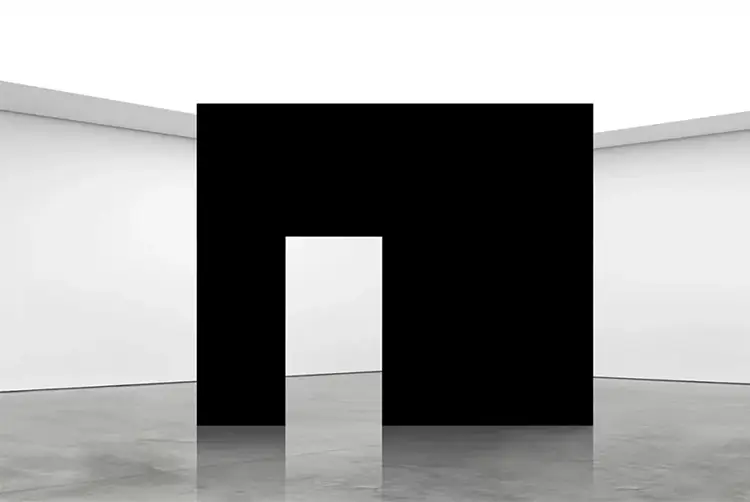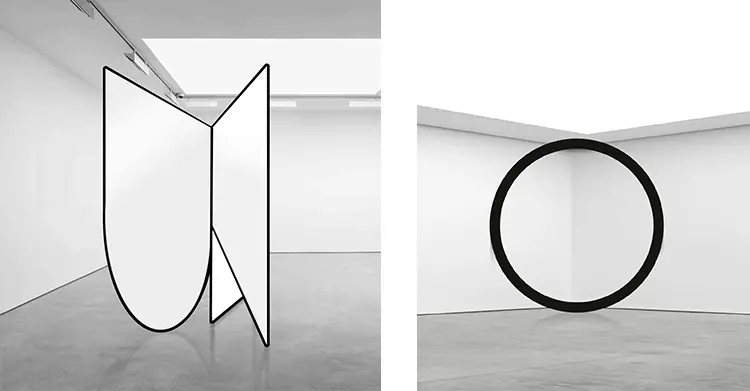Space Without Borders: The Art of Ambiguity
Few artists challenge the very structure of perception as rigorously as Mikael Christian Strøbek. His work resists easy classification, resting not within the categories of painting, sculpture, or installation, but rather in the undetermined areas that separate them. This deliberate positioning is not a stylistic choice for hybridity but a conceptual stance that interrogates how we define and experience visual forms. By embracing systemic methodologies rooted in geometry and serial logic, Strøbek constructs spaces where perception becomes almost tactile. In his view, the interstices—the implied, the undefined, and the assumed—hold more potential than the objects themselves. Through this approach, he crafts environments in which the viewer’s sensory experience becomes integral to the artwork.
Central to Strøbek’s visual language is a profound engagement with geometry. Unlike many artists who use geometric forms for symbolic or aesthetic purposes, Strøbek finds significance in their neutrality and conceptual breadth. Shapes like circles and squares are devoid of cultural or emotional baggage, allowing them to function as pure frames for contemplation. Their abstraction offers scalability and openness; a circle might be read as boundless or infinitesimal depending on one’s perspective. For Strøbek, this quality renders geometric forms ideal for generating spaces of interpretive freedom. Within an increasingly overstimulated visual culture, his compositions create rare moments of pause, where clarity emerges not from instruction, but from the viewer’s encounter with spatial purity.
The visual neutrality that defines his practice is carefully maintained through a process that consciously steps away from overt subjectivity. Strøbek’s use of color, particularly black, exemplifies this principle. Rather than symbolizing personal emotion or thematic darkness, black operates as a spatial anchor—a conceptual “background” pulled into physical form. When black surfaces occupy three-dimensional space, they challenge our visual instincts, flattening or asserting themselves unpredictably. This disruption of perceptual expectation is key to his artistic philosophy. Through such choices, Strøbek constructs a quiet yet persistent tension—a liminal condition where objects seem to hover between states, never settling into a fixed identity.

Mikael Christian Strøbek: Sculpting the In-Between
Strøbek’s sustained interest in liminality—transitional states and undefined boundaries—shapes nearly every facet of his practice. His works don’t merely occupy space; they redefine it by redirecting the viewer’s focus toward overlooked zones of interaction. Instead of emphasizing objects themselves, Strøbek invites attention to the spaces between them—the silent intervals that often go unnoticed but are crucial to meaning. His choice of materials—cardboard, glass, corten steel, stone—are deliberately industrial and neutral, enabling him to construct forms that emphasize voids and intersections rather than mass. In this way, space becomes an active component in his installations, a tool to redirect perception rather than a passive container for objects.
This conceptualization of space finds a direct application in the artist’s process, especially in his digital preparation. Strøbek begins many of his projects by sketching on an iPad, using a consistent virtual environment: a neutrally lit white room rendered in classical two-point perspective. Within this simulated architectural setting, he tests configurations, proportions, and spatial alignments with a freedom that physical materials do not allow. Though entirely pixel-based, these studies reveal a surprising sense of spatial realism. For Strøbek, this digital white cube becomes more than a sketchpad—it functions as a laboratory for intuition and an arena for conceptual exploration. The digital and the physical do not compete in his process; instead, they inform and sharpen one another.
Two of his most compelling recent works—Five Space Square (2021) and Glass Threshold (2021)—exemplify his continued fascination with materiality and perceptual transformation. Five Space Square presents a series of natural materials—sand and stone—organized in a progression from fine to coarse, framed by rusted corten steel. This sequencing not only articulates the material continuum but also reorients our understanding of the earth’s surface by turning the vertical into horizontal. Glass Threshold, by contrast, engages with the properties of transparency and reflection. The green hue in the glass is not artificially applied, but a natural result of iron oxide, reinforcing the artist’s commitment to neutrality. In both works, Strøbek reframes the familiar through subtle shifts in orientation and material context, prompting viewers to question their own spatial awareness.

Perception as Medium
One of the most intellectually provocative dimensions of Strøbek’s work is its interrogation of perception itself. Drawing on early influences from trompe-l’œil, his installations often manipulate visual cues to create fleeting illusions, which are then quickly dismantled by physical movement. A striking example of this is Four Circles (v), an early work that appears, from a single vantage point, to show four stacked black circles hovering in a room’s corner. Upon shifting position, the illusion breaks; the circles are revealed to be painted half-forms on adjoining walls. This gentle deception isn’t a trick for its own sake—it functions as a conceptual rupture, a way of revealing the instability of visual truth. By destabilizing the viewer’s assumptions, Strøbek opens space for deeper reflection on how reality is constructed.
This perceptual play is never about spectacle but rather about recalibration. Strøbek’s installations encourage a heightened sense of presence, a recalibrated awareness of space and one’s position within it. When walking through Glass Threshold, for instance, viewers become acutely aware of their bodies—the sound of footsteps, the rhythm of breath, the weight of silence. The work doesn’t impose meaning; it activates awareness. This activation is where Strøbek sees the potential of art—not in the object alone, but in its capacity to produce thought and sensation. In this respect, his approach shares kinship with artists like Olafur Eliasson, who famously suggested that the true power of art lies in its effects on the world, not in its physical form.
For Strøbek, art functions as an open proposition, a site of encounter rather than a vessel of fixed meaning. He intentionally leaves space for diverse interpretations, welcoming the personal, the intuitive, and even the contradictory. Each viewer arrives with their own histories and references, and in engaging with his work, they complete it in unique ways. This radical openness reflects his belief that art should democratize experience rather than prescribe it. Meaning, in his framework, is not an outcome imposed by the artist, but a dialogue initiated by the object and completed by its audience. In this way, his installations become not just structures in space, but shared experiences unfolding across time and perception.

Mikael Christian Strøbek: Rewriting the Role of the Artist
Strøbek does not view himself as a traditional maker of objects, but as a facilitator of experience. His role, as he defines it, is not to narrate or to resolve, but to construct conditions where reflection can occur. This self-conception shifts the artist’s responsibility from expression to configuration—from projecting meaning to hosting it. Through minimalist gestures and neutral materials, he crafts scenarios that resist distraction and noise. These are not grandiose declarations, but quiet interventions that prompt a slowing down, a reconsideration of space, material, and self. In this framing, art becomes less an act of creation and more a form of spatial storytelling—narratives told through form and felt through presence.
The artist’s refusal to define his work’s meaning is not a lack of intent but a strategic resistance to closure. By avoiding personal symbolism and emotional cues, Strøbek places trust in the viewer’s interpretive agency. Whether standing before a suspended glass pane or walking alongside a grid of arranged stones, the spectator is never passive. Each work demands attention, movement, and a willingness to confront ambiguity. This respect for the viewer’s autonomy is central to his ethos. Rather than offering resolution, Strøbek’s installations ask questions—about scale, orientation, materiality, and perception—that may never be fully answered, but are always worth considering.
Within today’s increasingly interdisciplinary and conceptually fluid art landscape, Strøbek’s approach stands out for its clarity of purpose and quiet conviction. He embraces the instability of boundaries not to blur them for novelty’s sake, but to emphasize their generative potential. Painting, sculpture, and installation are not endpoints but starting conditions—frameworks that can be stretched, reframed, or even undone. His art doesn’t scream to be understood; it whispers to be noticed. In an age dominated by spectacle and speed, Strøbek offers a counterpoint: a space for stillness, for precision, and for the endless variability of perception. Through his work, he reasserts the value of ambiguity—not as confusion, but as freedom.








